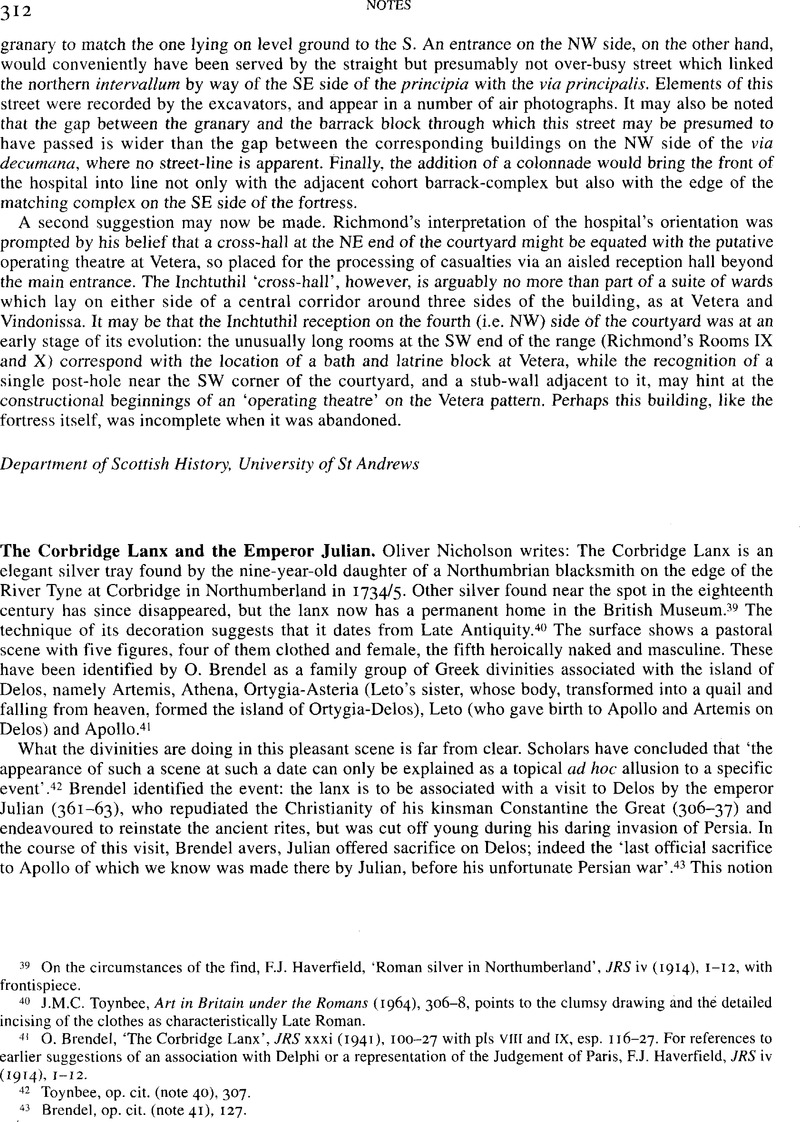No CrossRef data available.
Article contents
The Corbridge Lanx and the Emperor Julian
Published online by Cambridge University Press: 09 November 2011
Abstract

- Type
- Notes
- Information
- Copyright
- Copyright © Oliver Nicholson 1995. Exclusive Licence to Publish: The Society for the Promotion of Roman Studies
References
39 On the circumstances of the find, Haverfield, F.J., ‘Roman silver in Northumberland’, JRS iv (1914), 1–12, with frontispiece.Google Scholar
40 J.M.C. Toynbee, Art in Britain under the Romans (1964), 306–8, points to the clumsy drawing and the detailed incising of the clothes as characteristically Late Roman.
41 Brendel, O., ‘The Corbridge Lanx’, JRS xxxi (1941), 100–27Google Scholar with pis VIII and IX, esp. 116–27. For references to earlier suggestions of an association with Delphi or a representation of the Judgement of Paris, Haverfield, F.J., JRS iv (1914), 1–12.Google Scholar
42 Toynbee, op. cit. (note 40), 307.
43 Brendel, op. cit. (note 41), 127.
44 Toynbee, op. cit. (note 40), 307, also sees an allusion to ‘the sacrifice offered to Apollo on Delos by Julian the Apostate in 363, when he was en route for the Persian War’. The label accompanying the lanx in the British Museum in July 1994 made a similar connection.
45 Bradbury, Scott, ‘Constantine and the problem of anti-pagan legislation in the fourth century’, Classical Philology lxxxix (1994), 120–39.CrossRefGoogle Scholar
46 Ammianus Marcellinus XXII.5.2.
47 Recent studies of Julian's neo-pagan revival include ‘The “pagan churches” of Maximinus Daia and Julian the Apostate’, Journ. Ecclesiastical Hist, xlv (1994), 1–10 and P. Athanassiadi, Julian: an Intellectual Biography (2nd edn, 1992).Google Scholar
48 Ammianu s Marcellinus XXV.4.17.
49 For Julian's movements before 361, T.D. Barnes Athanasius and Constantius (1993), 226–8.
50 Ammianus Marcellinus XXII.9, with further references in O. Seeck, Regesten der Kaiser und Päpste (1919), 209–10 and discussion of religious implications in G. Bowersock, Julian (1978), 85–7. The route is appoximately that described by David French, Roman Roads and Milestones of Asia Minor. Fasc. 1: The Pilgrims' Road, BAR Int. Ser. 105(1981).
51 Seeck, op. cit. (note 50), 211–13; Bowersock, op. cit. (note 50), 108-17. For Harran/Carrhae, Ammianus Marcellinus XXIII.3.1-3 (secret rites) and Theodoret, Church History III.26 = Theodoret Kirchengeschichte (ed. L. Parmentier, Griech. Christl. Schriftsteller 44), 205 = Patrologia Graeca 82, col. 1120 (human sacrifice).
52 Brendel, op. cit. (note 41), 127. Theodoret, Church History III.2I = Parmentier, p. 200 = Patrol. Graec. 82, col. 1114.
53 Brendel, op. cit. (note 41), 127.
54 Cyril of Alexandria, Adversus Julianum IX.307 B = Patrologia Graeca 76, col. 972 D.
55 Porphyry, De Abstinentia II.28.I (ed. J. Bouffartigue and M. Patillon, Porphyre: De l'abstinence II (1979), 95). Brendel, op. cit. (note 41), III, suggests that it is this altar which is represented on the Corbridge Lanx by the altar bearing what looks like a piece of fruit that stands beside the trunk of the tree, between Artemis and Athena.
56 For Porphyry's dependence on Theophrastus, J. Bernays Theophrastos Schrift über Frömmigkeit (1866), esp. 32–5. De Abstinentia 11.27.2 records public human sacrifices ‘even now’ at the festivals on Mount Lycaeus in Arcadia and in honour of Saturn at Carthage, but by the late second century A.D. the ceremonies on Mount Lycaeus had become a private matter into which Pausanias preferred not to enquire (VIII.38.7) and the child sacrifices of Punic Carthage had long since been commuted to offerings of animals (T.D. Barnes, Tertullian (1971), 15–19).
57 Philostorgius, Church History VII, frag. 1 c = Artemii Passio 35 = Philostorgius Kirchengeschichte (ed. J. Bidez and F. Winkelmann, 2nd edn, Griech. Christl. Schriftsteller, 1972), 77; for other sources, Bowra, C.M., ‘ἴπατ ϵ τῶ βασιλιῆ’, Hermes lxxxvii (1959), 426–35.Google Scholar
58 Cicero, De imperio Cn. Pompei 18. 55, spoke of ‘Delus … quo omnes undique cum mercibus atque oneribus commeabant’. For a vivid evocation, T.P. Wiseman, Catullus and his World (1986), 92–6, 99–100.
59 At the time of Pausanias, the only inhabitants were the guards for the shrine sent out from Athens (VIII.33.2). For a hoard of coins lost on Delos in the 320s, Bruun, P., Studies in Constantinian Chronology, Numismatic Notes and Monographs 146 (1961), 78 ff.Google Scholar
60 P. Argent. 480, conveniently published in D.L. Page, Select Papyri III (Loeb Classical Library 360, 1941), p. 542–5, no. 135. T.D. Barnes, The New Empire of Diocletian and Constantine (1982), 54 n. 35, suggests that these are fragments of a panegyric uttered before Diocletian in Egypt in 298.
61 Latin Panegyric IX (Mynors) = V (Galletier), 18.2, dated by Barnes, op. cit. (note 60), 63, n. 77, to the summer or autumn of 298.
62 Ammianus Marcellinus XXII. 12.8, referring to the removal of burials from areas of the island within sight of the temple under Peisistratus (Herodotus 1.64) and from the entire island during the Peloponnesian War (Thucydides 1.8.1 and III. 104).
63 The phrase is from a geographical digression of Ammianus Marcellinus XXII.8.2.
64 Augustine, Confessions 1.13. 20–2 for his reading of Aen. IV; for notes on the epic simile comparing Aeneas and Apollo, Servius, Comm. in Aen. IV. 143–9.
65 For the transmission of myths as aniles fabulae, Arnobius, Adversus Gentes V.14.


